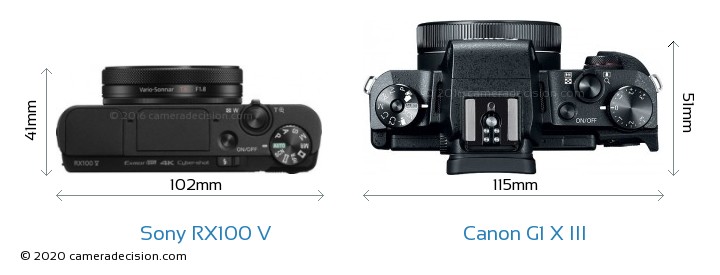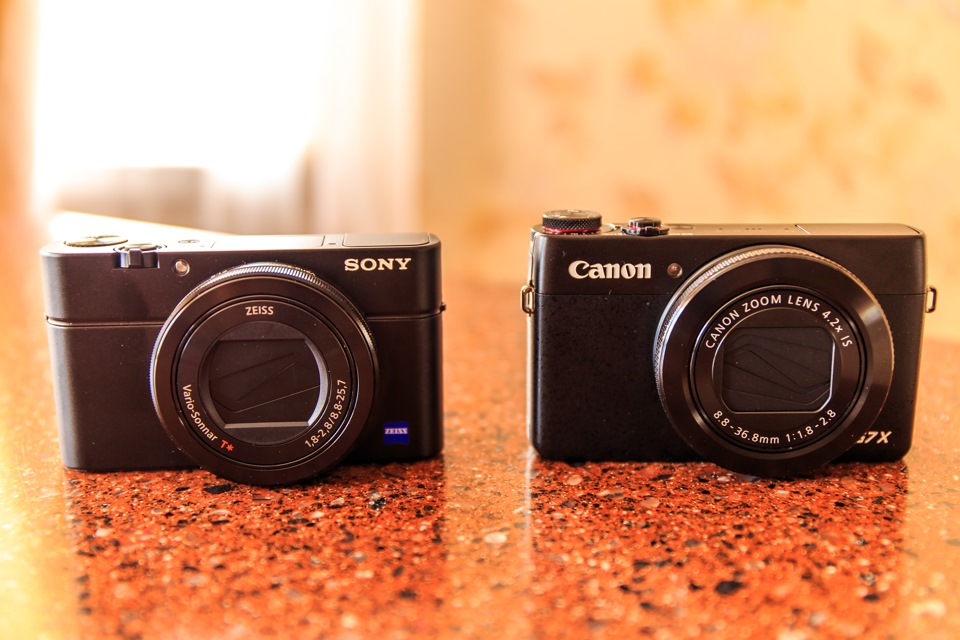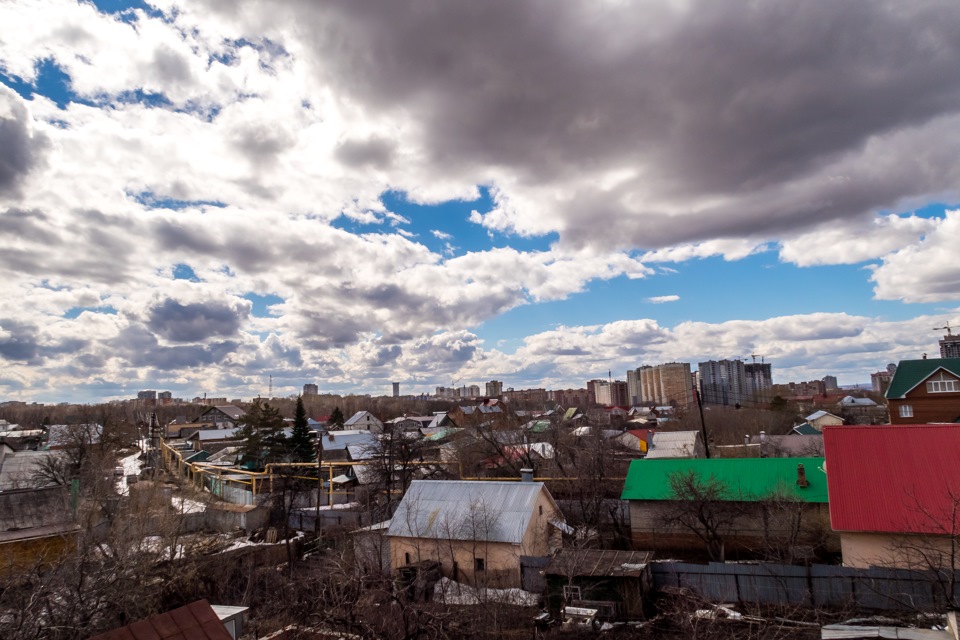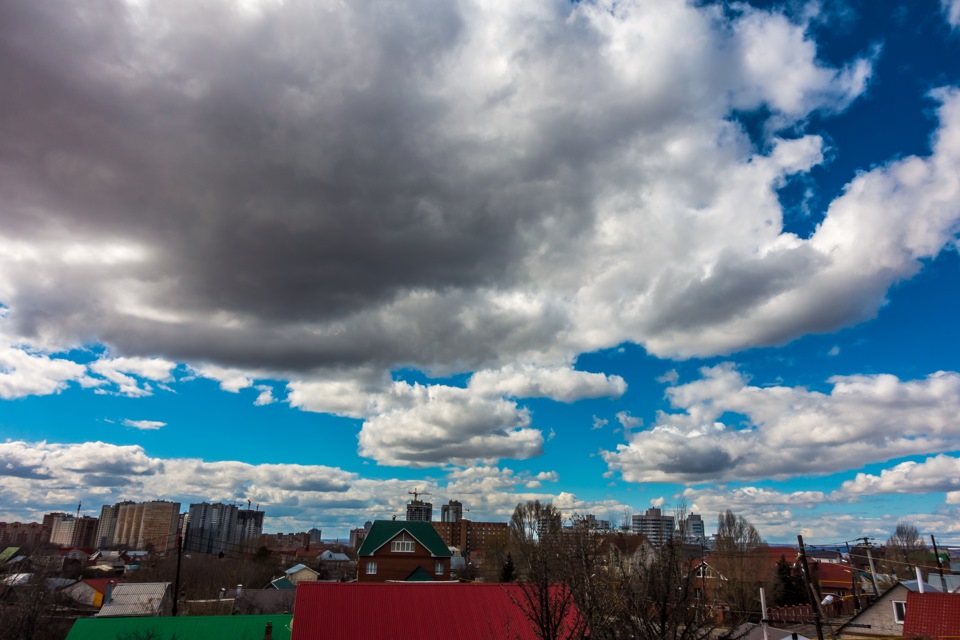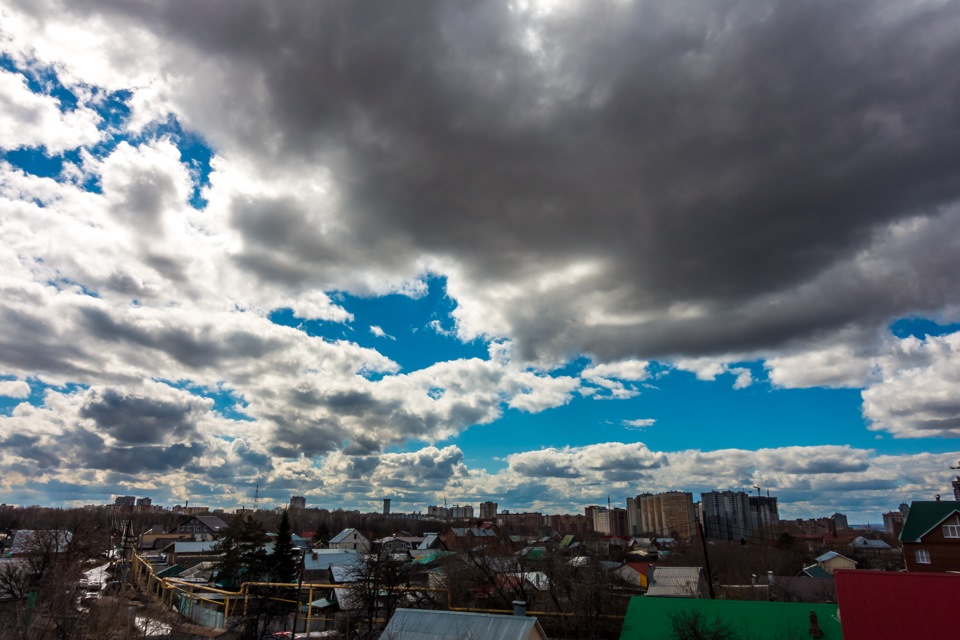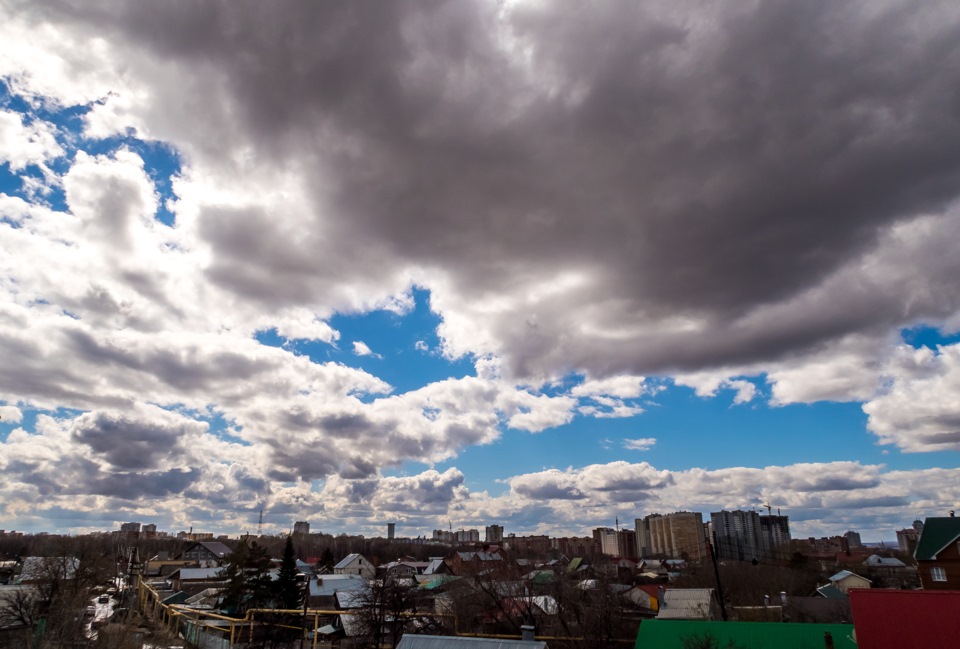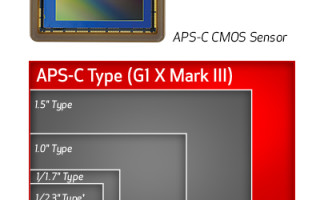Canon G1 X III vs Sony Cybershot RX100 V
Canon G1 X III vs Sony Cybershot RX100 V
The year is 2017. Smartphones have replaced compact cameras costing up to $200 and are already advancing on mirrorless cameras costing up to $500. The outlook looks bleak. But here! Camera makers have stumbled upon a niche that can soften the blow of mobile devices: ultra-expensive premium compacts.
Sony has been producing these cameras for a long time and there are five generations of them. Canon offers a wide range of large-sensor compacts, but none of them looked as promising as the G1 X Mark III. If you decide to buy a camera in this category and are willing to spend good money, then these two models will probably be on your list.
Sensor

In the Canon G1 X III you get a very familiar 24MP APS-C sensor with Canon's modern Dual Pixel technology. The RX100 V offers a much smaller 1-inch chip with 20MP resolution and an advanced multi-layer sensor design.
These two sensors produce quality images, but it's worth understanding that the G1 X III chip is much larger. This means the Canon camera can pull in more light, allowing for a little more flexibility in brighter, lighter and more contrasty scenes. But be careful: even though larger sensors generally perform better in low light and blur backgrounds more, this may not necessarily be true for daytime photography.
Lens

The G1 X III and V RX100 have lenses with an equivalent focal length of 24-70.
Sony offers an aperture of F1.8-2.8, while Canon offers an aperture of F2.8-5.6. You might be inclined to think that the RX100 V offers more flexibility for separating subjects from the background. Or collects more light in low light conditions. Or you might be inclined to think that Canon is better in both of these areas due to its larger sensor. Resist temptation. Repeat after me: equivalence is our friend.
Due to the difference in sensor size, the RX100 V lens has an equivalent aperture of F4.9-7.6 relative to full frame. Canon equivalent to F4.5-9. It turns out that Sony will be better at the long end, and Canon is marginally better at the wide-angle focal length. Either way, you get a zoom range that's useful for a wide range of shooting situations.
Autofocus

Canon's 24MP chip offers the proven Dual Pixel autofocus that has long captivated users of DSLRs and EOS-M mirrorless cameras. Sony, in turn, offers phase detection autofocus with a total of 315 points; Both cameras offer AF point coverage across most of the frame.
Overall, the RX100 V focuses better and is faster in burst shooting than most cameras with Dual Pixel technology. Even with an impressive 24fps continuous shooting speed, the RX100 V continues to focus without errors. Both cameras have equivalent autofocus in single-frame shooting. Sony has a handy Eye Focus mode, although the G1 X III offers the benefit of touchscreen convenience. Each system has its pros and cons, but they are both miles ahead of the contrast detection systems used by cheaper compacts and many smartphones.
Screen and viewfinder

Good news. Both cameras offer a built-in electronic viewfinder, which is not surprising given the cost of the cameras. But there are significant differences in the rear screen. Canon gives you a fully rotatable 3-inch 1.04MP touch screen. Sony offers a higher resolution 3-inch screen, which is 1.23MP with tilt-only functionality and no touch controls.
If you're, say, recording a YouTube video, Canon's fully rotatable touchscreen will clearly work better for you. Not everyone needs a touchscreen, but it will help you get the most out of the super fast autofocus system.
Video
In terms of pure video capabilities, the RX100 V comes out ahead with 4K resolution and 30 frames per second resampling from 5K video footage. FullHD 1080p is available at 120fps and 60fps, there's SLog2 for wide dynamic range capture and useful tools like zebra and focus peaking.
The Canon G1 X III offers a banal 1080/60p, which looks paltry compared to the Sony. However, the combination of the Dual Pixel AF system and the touch screen is incredibly useful for creating smoothly flowing focus from one subject to another. Effective tracking of a moving object is also available.
If you're an advanced videographer and want all the features you need to get the best quality video possible, then the RX100 V is for you. But if you are a beginner and want to create beautiful videos without much effort, then you should pay attention to the G1 X III.
Battery

Both cameras are not very good at this characteristic. The batteries of both of these cameras are weak. The RX100 V is CIPA rated for up to 220 shots per charge, while the G1 X III is rated for 200 shots. Actual results are usually better than test results, but if you plan to shoot a lot in burst mode, buy a backup battery right away. A fancy compact camera with a dead battery becomes just a very expensive dummy.
The Camera and Imaging Association (CIPA) was able to develop a standardized battery life test for digital cameras. According to the testing scheme, the camera takes a photo every 30 seconds, half with flash and half without. After each shot, the image appears on the display. After every 10 shots, the camera turns off for a while and the cycle repeats. CIPA ratings replicate realistic consumer use of the camera.
The test is intended primarily for compact cameras, since users of professional DSLR and mirrorless devices behave a little differently when shooting.
However, this test allows you to compare the energy efficiency of cameras with each other. Obviously, a camera that scores 1000 photos on the CIPA test will last longer during shooting than a device that scores 500 photos.
As a rule, in real conditions the battery can provide several times more work of the camera than the CIPA rating indicates. For example, the Sony A7rII camera is rated at 290 frames, but actually allows you to take about 700 photos on a single charge.
Form factor

There is one nuance that excuses the shortcomings of both cameras. The size of their case is so small that it is hard to believe that the manufacturers fit all these advanced technologies into it. But you can't cheat the laws of physics: the G1 X III's much larger sensor makes the camera bigger. The RX100 V only has a 1-inch sensor and is also pocket-sized. With its bumpier viewfinder, protruding control dials and protruding grip, the G1 X III looks like a miniature DSLR.
If small cameras seem too fiddly, you probably won't like the RX100 V. If you want to carry a camera in your jacket pocket, you probably won't be comfortable doing so with the G1 X III.
Canon G1 X Mark III vs Sony RX100 VI
The Canon PowerShot G1 X Mark III and the Sony Cyber-shot DSC-RX100 VI are two digital cameras that were officially introduced, respectively, in October 2017 and June 2018. Both the G1X Mark III and the RX100 VI are fixed lens compact cameras that are based on an APS-C (G1X Mark III) and an one-inch (RX100 VI) sensor. The Canon has a resolution of 24 megapixels, whereas the Sony provides 20 MP.
Below is an overview of the main specs of the two cameras as a starting point for the comparison.
Headline Specifications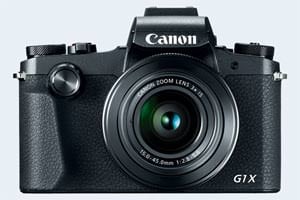 |
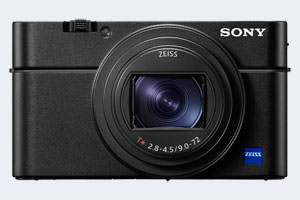 |
| Canon G1 X Mark III | Sony RX100 VI |
|---|---|
| Fixed lens compact camera | Fixed lens compact camera |
| 24-72mm f/2.8-5.6 | 24-200mm f/2.8-4.5 |
| 24 MP, APS-C Sensor | 20 MP, 1″ Sensor |
| 1080/60p Video | 4K/30p Video |
| ISO 100-25600 | ISO 125-12800 (80-25600) |
| Electronic viewfinder (2360k dots) | Electronic viewfinder (2359k dots) |
| 3.0″ LCD, 1040k dots | 3.0″ LCD, 1229k dots |
| Swivel touchscreen | Tilting touchscreen |
| 9 shutter flaps per second | 24 shutter flaps per second |
| Weathersealed body | Not weather sealed |
| 200 shots per battery charge | 240 shots per battery charge |
| 115 x 78 x 51 mm, 399 g | 102 x 58 x 43 mm, 301 g |
Going beyond this snapshot of core features and characteristics, what are the differences between the Canon PowerShot G1 X Mark III and the Sony Cyber-shot DSC-RX100 VI? Which one should you buy? Read on to find out how these two cameras compare with respect to their body size, their imaging sensors, their shooting features, their input-output connections, and their reception by expert reviewers.
Body comparison
An illustration of the physical size and weight of the Canon G1 X Mark III and the Sony RX100 VI is provided in the side-by-side display below. The two cameras are presented according to their relative size . Three successful views from the front, the top, and the rear are shown. All size dimensions are rounded to the nearest millimeter.
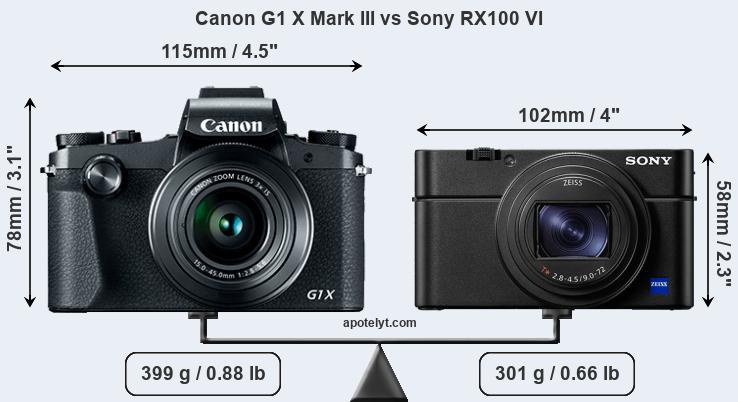
If the front view area (width x height) of the cameras is taken as an aggregate measure of their size, the Sony RX100 VI is considerably smaller (34 percent) than the Canon G1 X Mark III. Moreover, the RX100 VI is markedly lighter (25 percent) than the G1X Mark III. It is worth mentioning in this context that the G1X Mark III is splash and dust resistant , while the RX100 VI does not feature any corresponding weather-sealing.
Concerning battery life, the G1X Mark III gets 200 shots out of its NB-13L battery, while the RX100 VI can take 240 images on a single charge of its NP-BX1 power pack. The power pack in the RX100 VI can be charged via the USB port , which can be very convenient when traveling.
The table below summarizes the key physical specs of the two cameras alongs >use the right or left arrows in the table to switch to the respective cameras. Alternatively, you can also navigate to the CAM-parator app and make your selection from the full list of cameras there.
Camera Body Specifications| Camera Model |
Camera Width |
Camera Height |
Camera Depth |
Camera Weight |
Battery Life (CIPA) |
Weather Sealing (yes/no) |
Camera Launch (announced) |
Launch Price (USD) |
Street Price (USD) |
Used Price (USD) |
Camera Model |
|
|---|---|---|---|---|---|---|---|---|---|---|---|---|
| Canon G1 X Mark III » | 115 mm | 78 mm | 51mm | 399 g | 200 | Y | Oct 2017 | 1,299 | Canon G1 X Mark III | |||
| Sony RX100 VI « | 102 mm | 58 mm | 43 mm | 301 g | 240 | n | Jun 2018 | 1,199 | — | Sony RX100 VI | ||
| Canon 2000D « » | 129 mm | 101 mm | 78 mm | 475 g | 500 | n | Feb 2018 | 449 | Canon 2000D | |||
| Canon M50 « » | 116 mm | 88 mm | 59 mm | 390 g | 235 | n | Feb 2018 | 779 | Canon M50 | |||
| Canon 6D Mark II « » | 144 mm | 111 mm | 75 mm | 765 g | 1200 | Y | Jun 2017 | 1,999 | Canon 6D Mark II | |||
| Canon 200D « » | 122 mm | 93 mm | 70 mm | 453 g | 650 | n | Jun 2017 | 549 | — | Canon 200D | ||
| Canon G9 X Mark II « » | 98 mm | 58 mm | 31 mm | 206 g | 235 | n | Jan 2017 | 529 | Canon G9 X Mark II | |||
| Canon 80D « » | 139 mm | 105 mm | 79 mm | 730 g | 960 | Y | Feb 2016 | 1,199 | — | Canon 80D | ||
| Canon SX540 « » | 120 mm | 82 mm | 92 mm | 442 g | 205 | n | Jan 2016 | 399 | Canon SX540 | |||
| Fujifilm X100F « » | 127 mm | 75 mm | 52 mm | 469 g | 390 | n | Jan 2017 | 1,299 | Fujifilm X100F | |||
| Leica C-LUX « » | 113 mm | 67 mm | 46 mm | 340 g | 370 | n | Jun 2018 | 1,049 | Leica C-LUX | |||
| Nikon D7500 « » | 136 mm | 104 mm | 73 mm | 720 g | 950 | Y | Apr 2017 | 1,299 | Nikon D7500 | |||
| Sony RX100 VII « » | 102 mm | 58 mm | 43 mm | 302 g | 260 | n | July 2019 | 1,199 | Sony RX100 VII | |||
| Sony RX10 III « » | 133 mm | 94 mm | 127 mm | 1051 g | 420 | Y | Mar 2016 | 1,499 | Sony RX10III | |||
| Sony RX100 V « » | 102 mm | 58 mm | 41 mm | 299 g | 220 | n | Oct 2016 | 999 | Sony RX100 V | |||
| Sony RX100 IV « » | 102 mm | 58 mm | 41 mm | 298 g | 280 | n | Jun 2015 | 999 | — | Sony RX100 IV | ||
| Convert to Imperial | ||||||||||||
| Note : Measurements and pricing do not include easily detachable parts, such as interchangeable lenses or optional viewfinders. | ||||||||||||
Any camera decision will obviously take relative prices into account. The manufacturer's suggested retail prices give an idea on the placement of the camera in the maker's lineup and the broader market. The RX100 VI was somewhat cheaper (by 8 percent) than the G1X Mark III at launch, but both cameras fell into the same price category. Normally, street prices remain initially close to the MSRP, but after a couple of months, the first discounts appear. Later in the product cycle and, in particular, when the replacement model is about to appear, further discounting and stock clearance sales often push the camera price considerably down.
Sensor comparison
The size of the sensor inside a digital camera is one of the key determinants of image quality . All other things equal, a large sensor will have larger individual pixel-units that offer better low-light sensitivity, wider dynamic range, and richer color-depth than smaller pixels in a sensor of the same technological generation. Further, a large sensor camera will give the photographer additional creative options when using shallow depth-of-field to isolate a subject from its background. On the downside, larger sensors tend to be associated with larger, more expensive camera bodies and lenses.
Of the two cameras under consideration, the Canon G1 X Mark III features an APS-C sensor and the Sony RX100 VI an one-inch sensor . The sensor area in the RX100 VI is 65 percent smaller. As a result of these sensor size differences, the cameras have a format factor of, respectively, 1.5 and 2.7. Both cameras have a native aspect ratio (sensor width to sensor height) of 3:2.
With 24MP, the G1X Mark III offers a higher resolution than the RX100 VI (20MP), but the G1X Mark III nevertheless has larger individual pixels (pixel pitch of 3.72μm versus 2.41μm for the RX100 VI) due to its larger sensor. However, the RX100 VI is a somewhat more recent model (by 7 months) than the G1X Mark III, and its sensor might have benefitted from technological advances during this time that enhance the light gathering capacity of its pixels.
The resolution advantage of the Canon G1 X Mark III implies greater flexibility for cropping images or the possibility to print larger pictures. The maximum print size of the G1X Mark III for good quality output (200 dots per inch) amounts to 30 x 20 inch or 76.2 x 50.8 cm, for very good quality (250 dpi) 24 x 16 inch or 61 x 40.6 cm, and for excellent quality (300 dpi) 20 x 13.3 inch or 50.8 x 33.9 cm. The corresponding values for the Sony RX100 VI are 27.4 x 18.2 inch or 69.5 x 46.3 cm for good quality, 21.9 x 14.6 inch or 55.6 x 37.1 cm for very good quality, and 18.2 x 12.2 inch or 46.3 x 30.9 cm for excellent quality prints .
The Canon PowerShot G1 X Mark III has a native sensitivity range from ISO 100 to ISO 25600. The corresponding ISO settings for the Sony Cyber-shot DSC-RX100 VI are ISO 125 to ISO 12800, with the possibility to increase the ISO range to 80 -25600.
For many cameras, data on sensor performance has been reported by DXO Mark. This service is based on lab testing and assigns an overall score to each camera sensor, as well as ratings for dynamic range (“DXO Landscape”), color depth (“DXO Portrait”), and low-light sensitivity (“DXO Sports” ). The adjacent table reports on the physical sensor characteristics and the outcomes of the DXO sensor quality tests for a sample of comparator-cameras.
Canon G1 X Mark III vs Sony RX100 V

The year is 2017. Smartphones have defeated compact cameras costing up to $200. Now they are creeping up, encroaching on the interchangeable lens camera market. The prospects for the photographic equipment market do not look rosy. But here! Camera makers have found a gap in the market that can soften the blow that mobile devices have dealt. This is an ultra-expensive premium compact.
Sony has already released five generations of cameras in this segment. Canon offers a wide range of large-sensor compacts, but none of them looked as promising as the G1 X Mark III.
Image sensor

The Canon G1 X III uses a very familiar 24MP APS-C sensor with modern Dual Pixel technology. The RX100 V offers a much smaller 1-inch 20MP sensor, but still boasts high-speed video shooting.
Both of these image sensors are very good, but the fact that the G1 X III chip is much more noticeable. This means the camera can receive more light, which will provide a little more flexibility in high-contrast scenes and low-light situations. But be careful: even though larger sensors generally perform better in low light and background blur, there are other characteristics as well.
Lens

The G1 X III and RX100 V have the same focal length range: 24-70mm equivalent magnification.
Sony offers an aperture of F1.8-2.8, while Canon offers an aperture of F2.8-5.6. You might think that the RX100 V offers more flexibility for separating subjects from the background or collecting more light in low-light situations. You might also think that Canon is better in all of the above situations due to its larger sensor. Avoid jumping to early conclusions. Repeat after me: equivalence is our friend.
Due to the size difference, the RX100 V lens is equivalent to F4.9-7.6 relative to a full frame sensor. The Canon equivalent is F4.5-9. So what you can see here is that Sony is a little better at the long end of focal lengths, while Canon has quite a bit of an advantage at the wide end. Either way, you get a zoom range that's useful for a wide variety of shooting situations.
Autofocus

Canon's 24-megapixel chip offers Dual Pixel autofocus, which has proven itself in the company's DSLR and mirrorless cameras. Sony offers phase detection autofocus, which has a total of 315 points. Both cameras basically offer autofocus that covers most of the frame.
The RX100 V can focus and track motion faster than most Dual Pixel cameras, even at an impressive 24fps. In time-lapse mode, the cameras have the same performance. The Sony camera's Eye Focus mode is convenient, although the G1 X III has the advantage of having a touchscreen. Each system has its pros and cons, but they are both miles ahead of the contrast detection systems found in cheaper compacts and many smartphones.
Screen and viewfinder

Both cameras offer a built-in electronic viewfinder. But there are significant differences in screen characteristics. Canon gives you a fully rotatable 3-inch touchscreen display with a resolution of 1.04MP. Sony offers a higher resolution 3-inch display. It is 1.23Mp. However, it can only tilt and does not have touch controls.
Not everyone needs a touchscreen, but it can help you get the most out of a fast autofocus system.
Video

In terms of video recording capabilities, the RX100 V takes the lead. The camera can record 4K video at 30 frames per second, upsampled from 5K, resulting in high-quality images. FullHD can be shot at 60fps and 120fps, with the ability to slow down and use the SLog2 color profile to capture wide dynamic range. There are also useful tools such as zebra crossing and focus peaking.
The G1 X III has a maximum resolution of Full HD and a frame rate of 60 per second. Looks puny compared to Sony. At the same time, the Dual Pixel autofocus system and the touch screen are very convenient when shooting video and allow you to work with autofocus in a way that is impossible in other cameras, making smooth transitions with just one touch. You can also mark the object whose movement should be tracked.
If you're an advanced videographer who needs every feature possible, or a casual user who wants high-detail video and can handle manual focusing, then the RX100 V is for you. But if you are a beginner and want to create beautiful videos without much effort, then you should prefer G1 X III.
Battery

There is no good news here. Battery life is short on both cameras. The RX100 V is CIPA rated to take up to 220 shots on a single charge, while the G1 X III is rated at 200 shots. Actual results are usually better than test results, but if you plan to shoot a lot for a long time, or go on a trip or outdoors with friends, stock up on backup batteries.
Form factor

It's worth noting that despite their shortcomings, both of these cameras use advanced technology. The body of both cameras is very small and given the characteristics, it seems incredible that all this fit inside. But you can't cheat the laws of physics: the G1 X III's much larger sensor makes the camera larger. The RX100 V only has a 1-inch sensor, so this camera can fit in your pocket. With its shorter grip, viewfinder, and protruding control dials, the G1 X III looks like a miniature DSLR.
If small cameras seem too fiddly, you probably won't like the RX100 V. If you want a camera that fits in your jacket pocket, then the G1 X III might be a little big.
Follow the news: Facebook, Vkontakte and Telegram
Canon PowerShot G1 X Mark III vs. Sony Cyber-shot DSC-RX100 V
Comparison
 |
 |
Sensor
Sensor size is generally a good indicator of the quality of the camera. Sensors can vary greatly in size. As a general rule, the bigger the sensor, the better the image quality.
Bigger sensors are more effective because they have more surface area to capture light. An important factor when comparing digital cameras is also camera generation. Generally, newer sensors will outperform the older ones.
Actual sensor size
2.86 : 1 (ratio) Canon PowerShot G1 X Mark III Sony Cyber-shot DSC-RX100 V| 332.27 mm² | vs | 116.16 mm² |
Pixel pitch tells you the distance from the center of one pixel (photosite) to the center of the next. It tells you how close the pixels are to each other.
The bigger the pixel pitch, the further apart they are and the bigger each pixel is. Bigger pixels tend to have better signal to noise ratio and greater dynamic range.
Pixel or photosite area affects how much light per pixel can be gathered. The larger it is the more light can be collected by a single pixel.
Larger pixels have the potential to collect more photons, resulting in greater dynamic range, while smaller pixels provide higher resolutions (more detail) for a given sensor size.
Pixel density tells you how many million pixels fit or would fit in one square cm of the sensor.
Higher pixel density means smaller pixels and lower pixel density means larger pixels.
Specs
Choose cameras to compare
Popular comparisons:
Diagonal
Diagonal is calculated by the use of Pythagorean theorem:
| Diagonal = √ | |||
| Diagonal = √ | |||
| Diagonal = √ | Pixel pitch = | sensor width in mm | × 1000 |
| sensor resolution width in pixels |
G1 X Mark III pixel pitch
Sensor w > Sensor resolution w >
| Pixel pitch = | 22.30 | × 1000 | = 3.7 µm |
| 6026 |
RX100 V pixel pitch
Sensor w > Sensor resolution w >
| Pixel pitch = | 13.20 | × 1000 | = 2.4 µm |
| 5492 |
Pixel area
You could also divide sensor surface area with effective megapixels:
| Pixel area = | sensor surface area in mm² |
| effective megapixels |
G1 X Mark III pixel area
Pixel pitch = 3.7 µm
RX100 V pixel area
Pixel pitch = 2.4 µm
Pixel density
Pixel density can be calculated with the following formula:
| Pixel density = ( | sensor resolution width in pixels | )² / 1000000 |
| sensor width in cm |
One could also use this formula:
| Pixel density = | effective megapixels × 1000000 | / 10000 |
| sensor surface area in mm² |
G1 X Mark III pixel density
RX100 V pixel density
Sensor resolution
Sensor resolution is calculated from sensor size and effective megapixels. It's slightly higher than maximum (not interpolated) image resolution which is usually stated on camera specifications. Sensor resolution is used in pixel pitch, pixel area, and pixel density formula. For the sake of simplicity, we're going to calculate it in 3 stages.
1. First we need to find the ratio between horizontal and vertical length by dividing the former with the latter (aspect ratio). It's usually 1.33 (4:3) or 1.5 (3:2), but not always.
2. With the ratio ( r ) known we can calculate the X from the formula below, where X is a vertical number of pixels:
| ( X × r ) × X = effective megapixels × 1000000 → |
|
3. To get sensor resolution we then multiply X with the corresponding ratio:
Resolution horizontal: X × r
Resolution vertical: X
G1 X Mark III sensor resolution
Sensor w > Sensor height = 14.90 mm
Effective megapixels = 24.20
| r = 22.30/14.90 = 1.5 |
|






